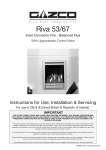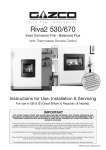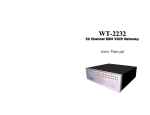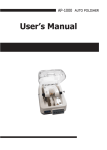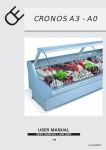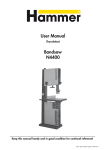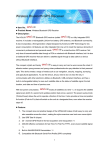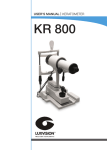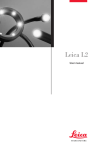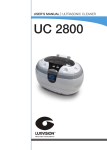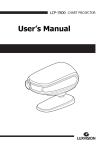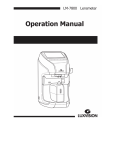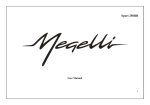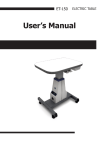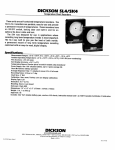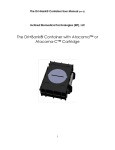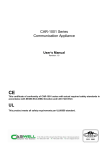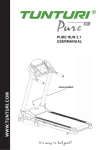Download User Manual
Transcript
Notification Dear Users, Thank you for your purchase of RU 1400 Refraction Unit. Please take time to read our user’s manual carefully before use. This guarantees you to make full use of this unit and prolongs the operation life of this unit. Precautions If you have detected abnormal heat, smoke, noise or smell, immediately stop using the product. In the event of an abnormality, turn off the power and disconnect the power plug from the power socket. Continuing to use the product may result in electric shock or fire. Observe the instructions given below regarding the power cable: • • • • • • Be sure to use the supplied or specified power cable. Do not modify, forcibly bend, kink or pull the power cable. When disconnecting the power cable from the AC outlet, be sure to hold the cable by the plug. Pulling the cable may cause wire breakage or shot circuit, resulting in fire or electric shock. Do not connect or disconnect the plug of the power cable to/from the AC outlet using wet hands. Doing so may result in electric shock. Do not touch the product with wet hands while the power cable is connected to the AC outlet. Doing so may result in electric shock. If the product will not be used for a long period, disconnect the power cable from the power source. Leaving the cable connected to the power socket for a prolonged period will consume electricity and may result in heating. Content 1. Package List .................................................................................................4 2. Name of Parts ...............................................................................................7 3. Assembly Process .........................................................................................9 4. Default Circuit Settings and Adjustment .......................................................15 5. Operation ....................................................................................................16 6. Possible failure and Repair ...........................................................................18 7. Wiring Diagram ............................................................................................19 8. Specifications ..............................................................................................22 1. Package List ID Name Qty. Figure 1 MainPart (including Base, Liftpart and Operating Board). 1 2 Rocker 1 3 ShortRod 1 4 LongRod 1 5 Lamp 1 4 ID Name Qty. Figure 6 Back 1 7 Cannula 1 8 Hex Socket Cap Screw ISO 4762-M8X120 1 9 Projector Flat and Countersunk Flat Head Screw 1 10 Power Cable 11 Communication Cable 12 Fuse 5A 5 ID Name Qty. Figure 13 Hex Spanners 4 14 Wrench 1 15 Manual 1 16 Acceptance Certificate 1 6 2. Name of Parts Refer to figure 16 and Figure 1 to understand the instrument’s components. 23 22 1 21 2 3 20 4 19 18 5 6 7 17 8 16 9 10 15 11 14 12 13 Fig.1 Components diagram (1) 7 26 27 28 24 25 Fig.2 Components diagram (2) 1. Projector Flat 2. Rocker Installing Rod 3. Rocker 4. Back 5. Armrest 6. Operating Board 7. DC Output Voltage Adjustment 8. Chiar down/up botton 9. Cushion 10. Chair Frame 11. Chair Cover 12. Baffle 13. Footboard 14. Base 15. Mainframe 16. Panel 17. Handle 18. ShortRod 19. Cannula 20. Rocker locker 21. LongRod 22. Connector Pipe 23. Lamp 24. Screws 25. Power Switch 26. HorizontalRod on Rocker 27. Headrest 28. Lifting Switch 8 3. Assembly Process 1. First at all, you should place the MainPart on a flat. 2. Unscrew the two screws on the back of the MainPart, so you can open it’s back (fig.3) Fig.3 Unfix the back 3. Unscrew the screw and washer on the end of the ShortRod (fig.4) Fig.4 Unscrew screw and washer 4. Fit the ShortRod on the MainPart according to the place showed in figure 5. In this step, do not make the screw completely fixed, so that you can adjust the position of the ShortRod. 9 Fig. 5 Assembly ShortRod 5. Before mounting the LongRod on the MainPart with the same way as step 3 ~ 4, you should unscrew the screw and washer at the end of the LongRod (see fig.6), and the four screws on the other end of it (fig.7). See Figure 6 ~ 8. Fig 6 Unscrew the screw and washer on LongRod Fig.7 Unscrew the four screws 10 Fig. 8 Assembly LongRod 6. Place the Cannula between the Rods, and adjust the Rods’ position to keep the three holes in line. Insert the Hex Socket Cap Screw ISO 4762 - M8x120 into the ShortRod. Cannula and the LongRod. Before fixing the screw, you need to adjust the ShortRod and the LongRod, keep them vertical to the ground. (Fig 9) Fig. 9 Assembly the Cannula 7. Pull out the wires from the Lamp, connect each wire to the wire with the same color in the LongRod. (Fig.10) Fig. 10 Connect Wires 11 8. In order to keep the lamp horizontal, one person should buttress the lamp in this step. Adjust the lamp to the right position, and fix the four screws unscrewed from the LongRod to the corresponding position and make them tightened, (fig.7). See the figure 11. Fig.11 Assembly the Lamp 9. After the ShortRod, LongRod and the Lamp has been set up, you should adjust their position to keep the ShortRod and LongRod vertical to the ground. At last, tighten each screws (fig.5, 8 ,9). 10. Unscrew the three bolts and nuts on the chair of the MainPart. see figure 12. Three bolts and nuts Fig.12 Unscrew three bolts and nuts 11. Align the three holes on the Back and their corresponding holes on the chair, fix the Back to MainPart reliably with the three bolds and nuts. See figure 13. 12 Fig.13 Fix the Back 12. Hang the Rocker onto the ShortRod, make sure that the Rocker can run softly and comfortably. See figure 14. Fig.14 Assembly the Rocker 13. To install the Projector Flat with the Countersunk Flat Head Screw. Keep the length of the power plug wire 260mm,see figure 15. On the back of Flat, there was fixed a universal, you need to test it’s swing motion. 13 Projector Flat and Countersunk Flat Head Screw Fig. 15 Assembly the Projector Flat 14. Connect the Projector wire and lighting wire respectively according to the connection diagram (see figure 16). Lighting wire AC Input Projector wire Fig.13 Connection diagram 15. Power on to test the wire connection. If connection is correct, fix the back of MainPart (fig.17); make sure that the two screws are not screwed so tight. Fig.17 Fix the back of the MainPart 14 Other Accessories Assembly 16. To install the Projector onto the Projector Flat with the screws, and plug in. 17. Hang up the Eyesight Detector onto the HorizontalRod of the Rocker, tighten its locking knob. Adjust the position of the detector via the handle on the Rocker, and then adjust it’s horizontality via the bubble cell on it. 18. Loose the handle of Rocker, Eyesight Detector will rise slowly. If not, you should adjust the strain of the controlling spring,see fig.18, the strain enhances during a clock-wise rotation, vice versa. Wrench Fig.18 Adjust spring strain 19. Set up the optometry facilities on the operating Board, connect its plugs into the outlet under the operating Board. 20. You can connect the wires for the two DC outputs on operating board. The two DC outputs can be adjusted to 3V, 6V, 9V, 12V or 24V. You can adjust on the mainboard, default is 12V. 4. Default Circuit Settings and Adjustment 1. The default setting of local voltage is 220V. When firstly installed, you should check that the transformer should be in accordance the local supply power (220V or 110V), see No.1 in Fig.19. 2. The default status of the computer power supply is always standby when power on. If you want to control the power by the button on controlling panel (see No. 3 15 in Fig 20), please take off the circuit ring (see No.2 in Fig 19) 3. About the two DC output on the platform. When the platform rotates outside 20 degrees, the power shut off. When the platform rotates back inside 20 degrees the power continues. If you pull out the plug on the rnainboard, the DV output is always standby in spite of platform rotating. 4. The flow bridge close to the circuit is left direct current. The flow bridge far form the circuit is right direct current. 5. The entry of the normal power made the chair works. 3 1 2 Fig.19 Mainboard Chart 5. Operation 1. Power on the facility, and press the [POWER] button on the Panel (No. 16 in fig. 1), the facility will stand by. 2. Press down the handle (No. 17 in fig. 1) on the Operating Board (No. 6 in fig. 1), you can move the Board to the left or right. When the Board moves to left, the DC output on left (default is 12V) power on, and the output on right is shut off, vice versa. 3. Press the height-adjust buttons ([ ][ ], the two buttons are located on the panel or on the front plane of the Board (No. 8 in fig. 1)), you can adjust the height of the chair. You can also use the switch on the back of the chair to do the same operation. 4. When the examination has been finished, you can move the Board to its origin, 16 and then rotate the Board 90-degree. 5. When you have to do some eyesight examinations, you can move the Eyesight Detector to the front of the patient, pull down the Rocker (No. 3 in fig. 1) to a suitable position, and lock the Rocker with it’s locker (No. 20 in fig. 1). If there is needed to adjust the height of the chair, do it as step 3; you should refer to a manual of the Eyesight Detector if you do not know how to operate it. 6. After the eyesight examination, you must loose the handle of the Rocker, move the Rocker to its onginal place, and lock it. 7. Here is a function list of the buttons on the panel (see Fig 20). 1 2 3 4 7 5 6 Fig 20 Panel 1. 2. 3. 4. 5. 6. 7. Lamp ON/OFF Projector ON/OFF Computer Outlet ON/OFF Chair down/up buttons Power ON/OFF Lamp BrightnessAdjustment Chair Restoration button 17 6. Possible Failure and Repair Here are some frequent failures or something happened possibly when you operate this combined table. You can examine the facility or repair it according to the list. Failures Possible reasons and repair suggestion 1 The indicator light has no light when power on Checking the fuse. Checking the status of the socket. 2 The indicator light has light but it doesn’t work yet. Checking if the plug of the control panel connect right. 3 It doesn’t work when started while the Checking if the control panel keeps perfect, power and the control panel is on. or if the voltage is be up to the standard. 4 The power of the projector isn’t on. Checking if the line of the projector is well connected, or if the whole line has short circuit. 5 The two DC supply power on the board isn’t prepared. Checking if the line is well connected, or if the plug is loose. 6 The switch of the controlling chair under the board shows no power. Checking if the switch keeps perfect, or if the line is connected in the right way. 7 The chair can rise but can’t go down. Checking if the journey switch under the table is normal. 8 The chair goes down automatically. Adjusting the screw on the electromagnetism. 9 The head lamp has no light. Checking if the lamp is damaged, or if the line is kept well. 10 When going up or down, there is a big noise with the engine. 11 It doesn’t work after checking the above questions. a) It shows that some place is leaked and the unilateral plug needs to be changed. Please contact with the factory or the maintenance place to change. b) It has low temperature in winter, the density of the oil is high, so it might happened, it will be OK in ten minutes or so after it is started. Contact with the factory or the maintenance place, let the professional check the instrument or replace the part. 18 7. Wiring Diagram The electric principle map 19 The electric system map 20 The line sketch map 21 8. Specifications Mechanical Parameters Angle of rotation for swing arm ±30 Table size(mm) 840 x 405 Angle of rotation for table 90° Table rnovement 0 ~ 330mm Angle of rotation for chair 60 Lifting height for chair 0-180mm Loading for chair 150Kg Lifting height for pillow 0 ~ 70 mm Backrest obliquity 90° ~ 135° to 900° ~ 140° Table and Case using complex material Color ivory and sapphire blue Electrical Parameters Input Voltage 110V/220V AC 50Hz ~ 60Hz Engine power 140W 220V AC Light Luminaire 15W 110V/220VAV Fuse 5A 250V AC Power without load 1W PressureTest 2KV Working mode S1 22 Main Wire 10A 250V Working Temperature -30°C ~ +50°C Relative Humidity less than 90% Force of Pressing key 1 ~ 5N Cooling mode Nature cooling Installation Dimension Figure size: 1400mm x 1000mm x 1990mm Weight: 98Kg 23 LUXVISION is not responsible or liable for indirect, special or consequential damages arising out of or in connection with the use or performance of the product or damages with respect to any economic loss, loss of property, loss of revenues or profits, loss of enjoyment or use, costs of removal or installation or other consequential damages of whatsoever nature. Some states do not allow the exclusion or limitation of incidental or consequential damages. Accordingly, the above limitation may not apply to you. Every effort has been made to ensure the accuracy of this manual. However, LUXVISION, makes no warranties with respect to the documentation and disclaims any implied warranties of merchantability and fitness for a particular purpose. LUXVISION, Inc. shall not be liable for any errors or for incidental or consequential damages in connection with the furnishing, performance, or use of this manual or the examples herein. The information in this document is subject to change without notice. 24
























